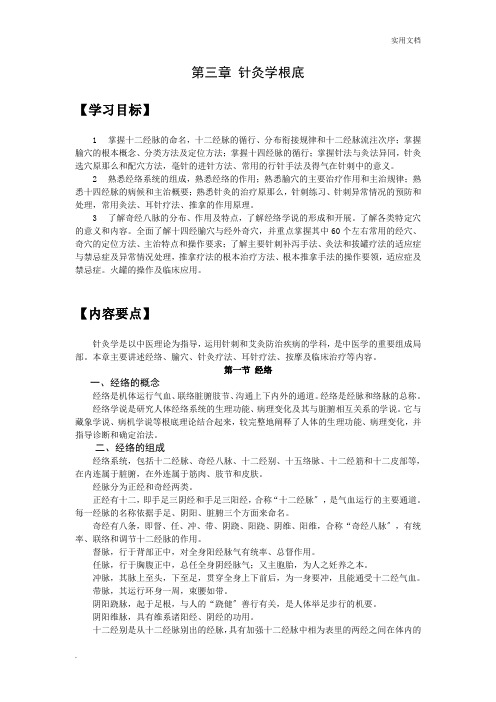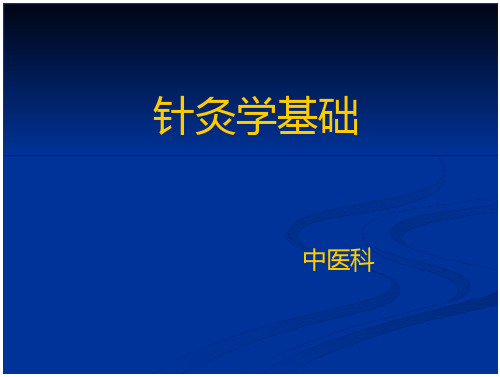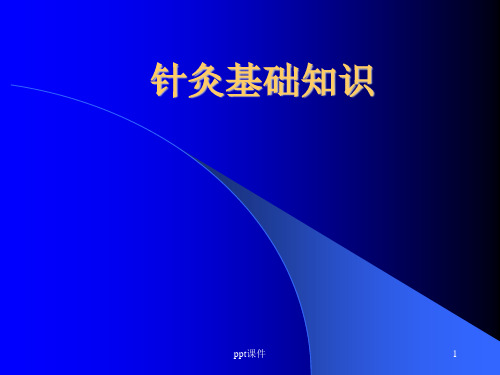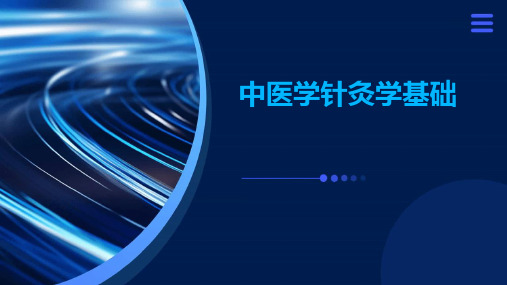中医学:下篇 第三章 针灸学基础
第三章 针灸学基础学习指导(合稿)

第三章针灸学根底【学习目标】1掌握十二经脉的命名,十二经脉的循行、分布衔接规律和十二经脉流注次序;掌握腧穴的根本概念、分类方法及定位方法;掌握十四经脉的循行;掌握针法与灸法异同,针灸选穴原那么和配穴方法,毫针的进针方法、常用的行针手法及得气在针刺中的意义。
2熟悉经络系统的组成,熟悉经络的作用;熟悉腧穴的主要治疗作用和主治规律;熟悉十四经脉的病候和主治概要;熟悉针灸的治疗原那么,针刺练习、针刺异常情况的预防和处理,常用灸法、耳针疗法、推拿的作用原理。
3了解奇经八脉的分布、作用及特点,了解经络学说的形成和开展。
了解各类特定穴的意义和内容。
全面了解十四经腧穴与经外奇穴,并重点掌握其中60个左右常用的经穴、奇穴的定位方法、主治特点和操作要求;了解主要针刺补泻手法、灸法和拔罐疗法的适应症与禁忌症及异常情况处理,推拿疗法的根本治疗方法、根本推拿手法的操作要领,适应症及禁忌症。
火罐的操作及临床应用。
【内容要点】针灸学是以中医理论为指导,运用针刺和艾灸防治疾病的学科,是中医学的重要组成局部。
本章主要讲述经络、腧穴、针灸疗法、耳针疗法、按摩及临床治疗等内容。
第一节经络一、经络的概念经络是机体运行气血、联络脏腑肢节、沟通上下内外的通道。
经络是经脉和络脉的总称。
经络学说是研究人体经络系统的生理功能、病理变化及其与脏腑相互关系的学说。
它与藏象学说、病机学说等根底理论结合起来,较完整地阐释了人体的生理功能、病理变化,并指导诊断和确定治法。
二、经络的组成经络系统,包括十二经脉、奇经八脉、十二经别、十五络脉、十二经筋和十二皮部等,在内连属于脏腑,在外连属于筋肉、肢节和皮肤。
经脉分为正经和奇经两类。
正经有十二,即手足三阴经和手足三阳经,合称“十二经脉〞,是气血运行的主要通道。
每一经脉的名称依据手足、阴阳、脏腑三个方面来命名。
奇经有八条,即督、任、冲、带、阴跷、阳跷、阴维、阳维,合称“奇经八脉〞,有统率、联络和调节十二经脉的作用。
中医学——针灸学基础

内科疾病的针灸治疗
消化系统疾病
针灸治疗慢性胃炎、胃溃疡、肠炎等消化系统疾病具有显著疗效 ,如针灸足三里、中脘等穴位可缓解胃痛、腹泻等症状。
呼吸系统疾病
针灸可用于治疗慢性支气管炎、哮喘等呼吸系统疾病。针灸肺俞、 风门等穴位可改善咳嗽、气喘等症状。
心血管系统疾病
针灸治疗高血压、冠心病等心血管系统疾病有一定的疗效。针灸内 关、神门等穴位可缓解心悸、胸闷等症状。
中医学——针灸学 基础
汇报人: 日期:
目录
• 中医学与针灸学概述 • 针灸学基础知识 • 针灸学临床应用 • 针灸学注意事项与禁忌 • 针灸学研究与发展趋势
01
中医学与针灸学概述
中医学的基本概念
整体观念
中医学认为人体是一个整体,各 个部分之间相互联系、相互影响 。在诊断和治疗时,注重整体调
节,而非仅针对局部症状。
腧穴是经络上的重要穴位,是针灸治疗的主要刺激点。每个腧穴都与特 定的经脉和脏腑相关联,通过针灸刺激腧穴可以调节相应脏腑的功能。
腧穴分类与定位方法
腧穴分类
根据腧穴所在位置和作用的不同,可将腧穴分为经穴、奇穴和阿是穴。经穴是位于十二经脉和奇经八脉上的穴位 ,具有主治本经疾病的功效;奇穴则分布于四肢和躯干部位,对某些疾病有特殊疗效;阿是穴则无固定位置,以 压痛点或病变部位为刺激点。
外科疾病的针灸治疗
1 2 3
软ቤተ መጻሕፍቲ ባይዱ织损伤
针灸对于颈肩综合征、腰肌劳损等软组织损伤具 有较好的疗效。针灸阿是穴、委中等穴位可缓解 疼痛、改善局部血液循环。
骨折与扭伤
针灸有助于促进骨折愈合、缓解疼痛,对于扭伤 也有较好的疗效。针灸特定穴位可改善局部血液 循环、促进炎症消退。
针灸学基础【中医科】

足三阴经
小指端 目内眦 足小指端心经 小肠经 膀胱经 肾经胸中心包经 三焦经 胆经 肝经肺中
无名指端
足大趾端
指导疾病的治疗
第二节 腧穴
节腧穴■ 腧穴的概念: 是脏腑 、经络之气输注于体表的特殊部位 , 也是疾病的反映点和针灸等治法的刺激点。■ 《灵枢 ·九针十二原》 说“神气之所游行出入也 , 非皮肉筋骨也 ”。说明腧穴并不是孤立的点 , 而是与深部组织器官有着密切联系 、互相输通的特殊部位。输通是双向的 , 从内通向外 , 反应病情 , 从外通向 内 , 接受刺激 , 防治疾病 。从这个意义上来说 , 腧 穴是疾病的反应点和治疗的刺激点。
一 、手太阴肺经
孔最列缺经渠 太渊 鱼际 少商
进入肘外侧 , 上行经过上臂伸侧前缘, 上肩 , 至肩关节前缘 , 向后到第七颈 椎棘突下(大椎穴) , 再向前下行入 锁骨上窝(缺盆) , 进入胸腔络于肺, 向下通过膈肌下行 , 属于大肠 。它的支脉 , 从锁骨上窝上行 , 经颈部 至面颊 , 进入下齿中 , 回出夹口两旁, 左右交叉于人中 。左边的向右 , 右边 的向左 , 上行至鼻翼旁(迎香穴) 入交于足阳明胃经 。 。
肝俞 、期门压痛 肝病足三里 、 胃俞 疼痛 胃病
体表相应腧穴部位
脏腑病变
反映于
■ 针灸 治 病 是 通 过 刺 灸 腧 穴, 以
指导疾病的治疗
《四总穴歌》: 肚腹三里留, 腰背委中求, 头项寻列缺, 面口合谷收。
■ 腧穴可以分为十四经穴 、经外奇穴 、 阿是穴。■ 十四经穴 :简称经穴 , 是指分布于十四经经脉偱行路线上的腧穴 , 共有361个 , 其中左右对称分布的有309对 , 单 穴即任脉 、督脉上的穴位共69个 , 这些腧穴都有固 定的名称 , 固定的位置 , 所属的经脉 , 是人体非常 重要的腧穴 , 这些腧穴都能治疗本经的病变 , 是临 床常用的腧穴。
针灸基础知识 ppt课件

针刺的角度和深度关系
--相辅相成 深刺多用直刺 浅刺多用斜刺或平刺 重要脏器部位的腧穴 延髓部、眼区、胸背部 尤其注意掌握,以防医疗事故发生。
ppt课件
37
(三)行针与得气
行针:针刺入腧穴后,为使病人产生针刺感应而施行一定 的手法。 得气:针刺部位产生酸、麻、胀、重的感觉 医者手下有沉紧感。 得气的意义: 得气迅速提示疗效颇佳; 得气缓慢提示疗效差; 无得气,疗效更差或无效,需行针催气或留针候气。 不得气的原因: 1 )取穴不准确; 2 )未能掌握好针刺角度和深度; 3)病人体质虚弱,经气不足,气行缓 慢,久候不至。 38 ppt课件
针灸基础知识
ppt课件
1
针灸基础知识
教学目的和要求: 1.掌握腧穴的定义、分类和主治作用。 2.掌握基本进针手法,得气得概念和常用
行针方法。
3.了解针刺意外的情况和处理方法。
4.了解针刺注意事项。
5.掌握灸法的分类。
ppt课件 2
一
针灸基础知识
(一)腧穴 acupoint
定义:人体脏腑经络之气输注于体表的部位,又称砭
ppt课件
25
自身练针法:
通过以上两步骤练习,有了一定的指力和掌握一 些行针手法后,可以在自身上进行试针。 双重含义: 术者可以体会到针尖达到不同组织结构以及得气 时持针手指的感觉; 被刺者也可以体会到针刺后产生的酸、麻、胀、 重的感觉。 要求: 进针无痛,针身不弯,刺入顺利,行针自如,指 力均匀,手法熟练,指感敏锐,针感出现快。
ppt课件 24
指力与针法的练习
速刺练习法:练习指力和捻转的基本手法。 左手拇指或食指爪切,右手持针,使针体垂直快速刺入 捻转练习法: 右手拇、食、中指持针,刺入以后拇指、中指做向前向后 来回捻转 要求:角度均匀,快慢自如( 150-200 次/分)。 提插练习法:右手拇、食、中指持针,刺入以后作上下 提插的动作 要求:深浅适宜
中医学——针灸学基础

中医学——针灸学基础pptxx年xx月xx日contents •针灸学简介•针灸学基础知识•针灸学基本技能•针灸学临床应用•针灸学发展前景与展望•其他相关知识和信息目录01针灸学简介起源起源于古代中国的砭石疗法。
发展历经数千年发展,逐渐完善并形成了完整的理论体系和多种治疗方法。
针灸学的起源和发展基本原理以经络学说和脏腑理论为基础,通过刺激穴位和调整经络来达到治疗疾病的目的。
方法包括毫针、艾灸、拔罐、刮痧等多种方法。
针灸学的基本原理和方法针灸学在现代医学中的应用针灸对各种疼痛,如颈肩腰腿痛、关节痛、神经痛等有很好的疗效。
疼痛治疗内科治疗美容美体康复治疗对多种内科疾病,如感冒、咳嗽、胃炎、腹泻等也有很好的疗效。
针灸可调节内分泌,改善肌肤问题,如痤疮、黄褐斑等,也可用于减肥和塑形。
对手术后康复和脊髓损伤等康复治疗有很好的效果。
02针灸学基础知识经络系统经络系统概述经络系统是针灸学的基础,包括十二经脉、奇经八脉、十五络脉、十二经别等,它们相互连接,构成了一个复杂的网络系统。
经络系统的功能经络系统的主要功能是沟通表里、联络脏腑、运行气血、调节阴阳平衡,对于人体的生理功能和病理变化有着重要的影响。
经络系统的应用经络系统在针灸学中具有重要的应用价值,通过对经络的刺激可以调和气血、平衡阴阳,达到治疗疾病的目的。
常用穴位在针灸学中,常用的穴位有数百个,如合谷、曲池、足三里、三阴交、涌泉等,每个穴位都有其独特的作用。
穴位系统概述穴位是经络上的重要节点,是针灸学治疗疾病的主要刺激点。
每个穴位都有其特定的名称、定位和主治功能。
穴位定位方法穴位定位是针灸学的基础技能,常用的定位方法有骨度分寸法、手指同身寸法、自然标志法等。
穴位系统刺灸技术概述刺灸技术是针灸学中重要的治疗手段,包括针刺和艾灸两种方法。
针刺是用针刺入皮肤来刺激穴位,而艾灸是用艾叶制成的艾条或艾柱对穴位进行热刺激。
针刺技术针刺技术包括进针、行针、留针、出针等步骤,根据不同的疾病和穴位选用不同的针具和刺激方法。
中医学针灸学基础

02
CATALOGUE
针灸操作方法与技巧
针具选择与消毒处理
针具选择
根据治疗需要选择不同规格、材质的 针具,如毫针、三棱针、皮肤针等。
消毒处理
采用高压蒸汽、煮沸或化学消毒等方 法对针具进行严格消毒,以防交叉感 染。
进针法、行针法及出针法
01ቤተ መጻሕፍቲ ባይዱ
02
03
进针法
掌握快速进针、缓慢进针 等不同进针方法,减轻患 者疼痛感。
VS
儿童
儿童针灸时应注意针具的选择,尽量使用 细短针,以减少疼痛。同时,应根据儿童 年龄和体质调整针刺深度和刺激强度,避 免过度刺激。
禁忌情况下避免使用或慎用针灸治疗
疲劳、饥饿、过饱、酒后等情 况下不宜针灸,以免引起晕针 等不良反应。
皮肤感染、溃疡、瘢痕等部位 不宜针灸,以免加重病情。
出血性疾病、恶性肿瘤等严重 疾病患者慎用针灸治疗,应在 医生指导下进行。
历史发展
针灸学起源于中国远古时代,形 成于战国至秦汉时期,发展于唐 宋元明清历代,近现代针灸学得 到进一步发展和完善。
经络系统与穴位分布
经络系统
经络是人体内运行气血、联系脏腑和体表及全身各部的通道,是人体功能的调 控系统。包括十二经脉、奇经八脉、十五络脉等。
穴位分布
穴位是经络气血输注于体表的部位,具有反映病症、协助诊断和接受刺激的作 用。穴位分布广泛,包括头面部、颈项部、胸腹部、腰背部、四肢部等。
感谢观看
利用大数据和人工智能技术,分析针 灸疗效,为个体化治疗提供依据。
提高普及率和认知度,推广至基层医疗机构
加强针灸知识宣传
通过媒体、讲座等形式,普及针 灸基本知识和疗效,提高公众认
知度。
培训基层医务人员
针灸学基础腧穴

针灸学基础腧穴•腧穴概述•经络腧穴理论•腧穴定位方法目录•常见病症腧穴配伍•针灸操作技术与注意事项•腧穴临床应用与研究进展腧穴是人体经络气血输注于体表的特殊部位,是疾病的反应点和针灸等治疗的刺激点。
腧穴发展腧穴学作为中医学的重要组成部分,经历了漫长的实践和理论总结过程,形成了以十四经脉为主体的腧穴体系。
根据不同的分类方法,可将腧穴分为十四经腧穴、奇穴、阿是穴等。
其中十四经腧穴位于十四经脉上,是临床上最常用的一类腧穴。
腧穴命名腧穴命名主要依据其所在部位、所在经络、所在穴位、治疗作用等因素,一般由“经穴名”+“位置”组成。
例如,“足三里”即位于足阳明胃经上的“三里”穴。
腧穴作用及选取腧穴作用腧穴具有治疗多种疾病的作用,如缓解疼痛、调理气血、平衡阴阳等。
同时,腧穴还具有反映疾病和辅助诊断的作用,如通过观察腧穴的异常反应可了解疾病的性质、部位和程度等。
腧穴选取在临床上,医生会根据患者的病情和需要选取适当的腧穴进行针灸等治疗。
选取腧穴时需要考虑患者的体质、年龄、性别等因素,以及疾病的性质、部位和程度等因素。
同时,还需要根据腧穴的分类和命名进行合理的选取。
经络系统包括十二经脉、奇经八脉、络脉等,它们相互连接、交织成网络,调节人体的气血和脏腑功能。
经络系统在人体内起着运行气血、沟通内外、平衡阴阳的作用,是人体生理和病理的重要基础。
经络是中医理论的重要组成部分,是针灸学的基础。
经络系统概述腧穴是经络上的重要节点,是经络气血汇聚和流通的关键点。
每个腧穴都有其特定的位置和主治范围,与相关的经络和脏腑有密切联系。
通过对腧穴的刺激和调节,可以疏通经络、调和气血、平衡阴阳,达到治疗疾病的目的。
腧穴与经络关系云门、中府、尺泽、孔最等。
手太阴肺经商阳、二间、三间、曲池等。
手阳明大肠经承泣、四白、足三里等。
足阳明胃经常见经络腧穴足太阴脾经:隐白、太白、三阴交等。
手少阴心经:少海、神门等。
手太阳小肠经:少泽、后溪等。
足太阳膀胱经:睛明、承山、昆仑等。
中医学针灸学基础

针灸学面临着传统技艺传承和 现代技术创新的双重挑战,需 要不断探索和创新。
06 针灸学研究与文 献综述
古代针灸学的研究与成就
起源与早期发展
针灸学起源于中国,已有数千年的历史。古代针灸学以经络学说和针灸技术为基础,逐步发展成为一个独特的医学体系。
经典著作与理论
《黄帝内经》是古代针灸学的经典著作之一,其中详细论述了人体的经络系统、针灸技术和治疗原则。此外,古代医家还提出了“针灸补泻”等理论,指导临 床实践。
禁忌症
对于一些特殊人群或特定疾病,针灸治疗存在一定的禁忌症。如孕妇腹部及腰骶部不宜施针,严重心 脑血管疾病及肝肾功能不全者也不宜施针。另外,皮肤感染、炎症及骨折未愈合的部位不宜施针。
04 针灸学在临床中 的应用
内科疾病的针灸治疗
消化系统疾病
针灸治疗慢性胃炎、胃溃疡、慢性肠炎等消 化系统疾病具有明显疗效。
针灸可以应用于多种疾病的治疗,包括神经系统、消化系统、呼吸系统等领域的疾 病。
针灸作为一种自然疗法,具有安全、有效、副作用小的优势,越来越受到现代医学 的重视。
针灸学的未来发展趋势与挑战
针灸学将进一步与现代医学结 合,以实现更高效、更安全的 治疗效果。
针灸学将进一步开展国际交流 与合作,以推动其在全球范围 内的普及和发展。
针灸可以辅助治疗阴道炎、盆腔炎等妇科 炎症疾病。
儿科疾病的针灸治疗
01
小儿腹泻
针灸对小儿腹泻的治疗效果明显 ,可迅速缓解症状。
小儿哮喘
针灸能够辅助治疗小儿哮喘,减 少发作次数和程度。
03
02
小儿遗尿
针灸对小儿遗尿有较好疗效,可 培养孩子的膀胱功能。
小儿厌食症
针灸可以调整小儿的脾胃功能, 改善厌食症状。
- 1、下载文档前请自行甄别文档内容的完整性,平台不提供额外的编辑、内容补充、找答案等附加服务。
- 2、"仅部分预览"的文档,不可在线预览部分如存在完整性等问题,可反馈申请退款(可完整预览的文档不适用该条件!)。
- 3、如文档侵犯您的权益,请联系客服反馈,我们会尽快为您处理(人工客服工作时间:9:00-18:30)。
1
第三章 针灸学基础
第一节 经络学说
Meridians & Collaterals
2
第三章 针灸学基础
第一节 经络学说
二经脉的流注次序。 2、熟悉经络系统的组成和经络的作用。 3、了解奇经八脉的分布、作用及特点。 4、了解经络的现代研究概况(课外自学)。
The system of meridian is composed of meridians and collaterals.
㈠经脉Main meridians
分为正经、奇经与经别,包括经筋、皮部。
Main meridians, being the trunk of meridian, may be classified into three categories:regular meridians, extra meridians, divergent meridians,including muscles along meridians and cutaneous regions.
8 返回目录
二、经络系统的组成
Composition of meridian system
经络系统简表(Meridian system )
经脉
十二经脉 奇经八脉
手足三阴经 手足三阳经
十二经别
经
经脉与络脉
十五别络
络脉 浮 络
络
孙络
系 统
内属
内外连属
络
外
十二经筋 十二皮部
返回本节
9 返回目录
经络系统是由经脉、络脉组成。
physiology,pathology,diagnosis and treatment in TCM.
经络学说-----研究人体经络系统的生理功能、病理变化 及其与脏腑相互关系的学说。 经络学说是针灸学的理论核心。不仅是针灸、推拿、气功 等学科的理论基础,而且对指导中医临床各科,均有十分 重要的意义。
返回本节
4 返回目录
一、经络的概念Concept of meridians
经络是经脉和络脉的总称。 经,路径,经脉——是经络系统中的直行主干部分。 络,网络,络脉——经脉的分支,较经脉细小,纵横 交错,遍布全身。
其中浮现于体表的络脉称为“浮络”,络还可再 分出更细小的分支称为“孙络”,不计其数。
Meridians include both meridians and collaterals. Meridians refer to the longitudinal trunk parts of the meridian system,while collaterals refer to the branches of meridians.Collaterals can be further divided into sub-collaterals.The shallow collaterals are called superficial collaterals which distribute all over the body.
3
一、经络的概念
Concept of meridians
经络----是机体运行气血、协调阴阳、联络脏 腑肢节、沟通上下内外的通路。
Meridians refer to the routes that transport qi and blood, regulate yin and yang,connect the zang-organs with the fu-organs,associate the external with the internal as well as the upper with the lower.
In this way meridians and collaterals form a network connecting all parts of the body,including the viscera,five sensory or gails,nine orifices,four limbs and skeleton,into an organic whole.
5
经脉与络脉的比较
①含义 ②粗细 ③走行方向 ④分布形式 ⑤深浅分布
经脉
经:路径 粗大,主干 纵行(个别特殊)
线状 多行于深部
络脉
络:网络 细小,分支 横、斜,纵横交错
网状布散,遍布全身 多行于浅部
6
经络构成了联系人体各部的网络结构系统,经络把人 体的五脏六腑、五官九窍、四肢百骸、皮肉筋脉等联 结成为一个统一的有机整体。使人体内的功能活动保 持相对的协调与平衡。
正经有十二,也叫“十二经脉” 奇经有八条,合称“奇经八脉” 经别有十二,称为“十二经别”
10
1.十二正经 Twelve regular meridians 十二正经即手、足三阴经和手、足三阳经,合称
“十二经脉”。 十二经脉的起止、循行部位、交接顺序、分布和走
向均有一定规律,且与脏腑有直接络属关系,是人体 气血运行的主要通道。
Twelve regular meridians, also collectively termed as "the twelve
main meridians", include three yin meridians of hand, three yin meridians of foot, three yang meridians of hand and three yin meridians of foot. These twelve meridians act as the main pathways in which qi and blood circulate throughout the body. They start and terminate at given sites, circulate along fixed routes, convergent in definite orders, distribute and flow with certain rules and are directly connected with certain viscera.
7
经络理论与藏象理论、气血津液理论等共同构成中医学理 论的基础,是中医基础理论的重要组成部分,贯穿于中医 学的生理、病理、诊断和治疗等各个方面。
The theory of meridians,the theory of viscera and the theory of qi,blood and body fluids constitute the theoretic base of TCM and run through the
